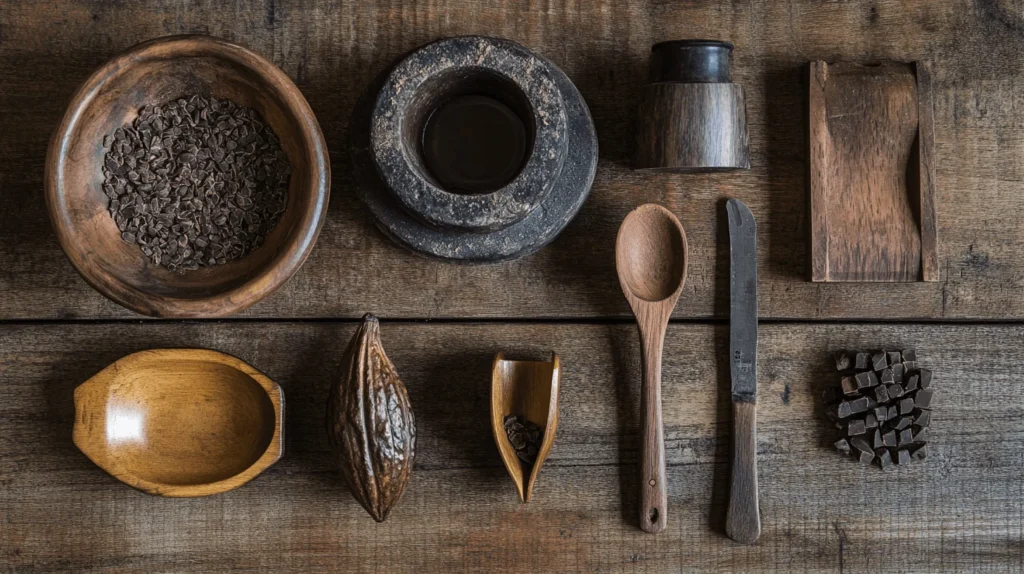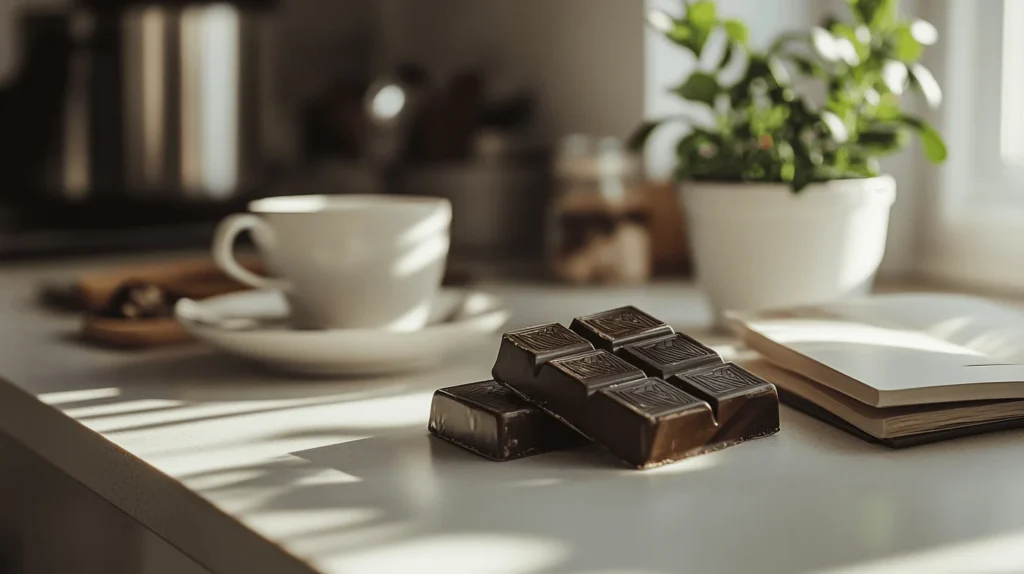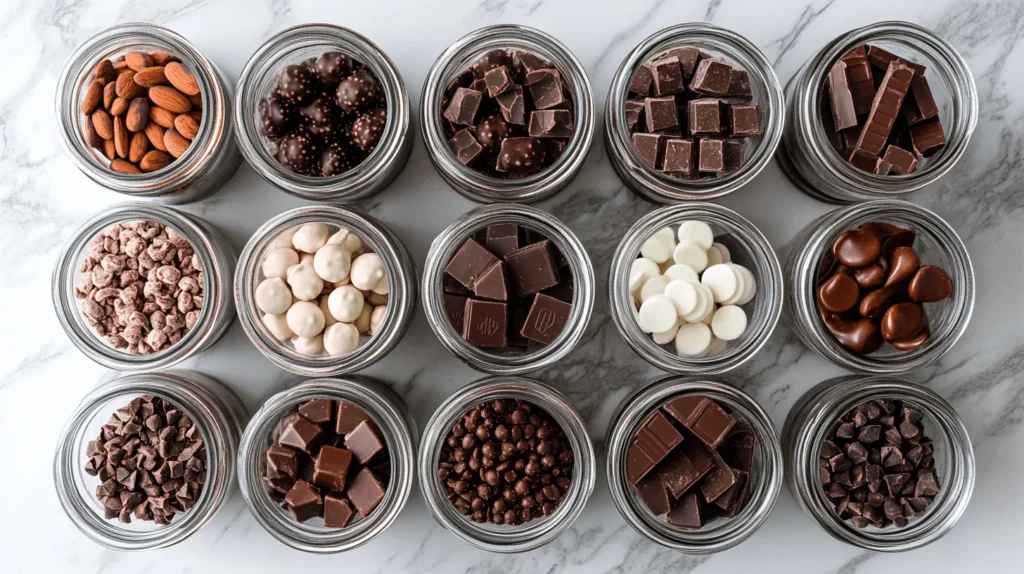Chocolate ranks among the most beloved treats worldwide, known for its rich, sweet flavor and versatility. Whether enjoyed as a bar, in a drink, or as an ingredient in desserts, chocolate comes in many forms. However, chocolate lovers often wonder: Is chocolate safe to eat if not refrigerated? Understanding how chocolate behaves when exposed to different temperatures and conditions helps make informed decisions about its storage and consumption. This article provides an answer, discussing the science of chocolate, the various types of chocolate, and best storage practices to ensure safe enjoyment.
The Science Behind Chocolate

How Chocolate Is Made and Its Sensitivity to Temperature
Chocolate undergoes a multi-step process that includes fermenting, drying, roasting, grinding, and mixing cocoa beans with sugar, milk, and other ingredients. Once mixed, chocolatiers temper and mold the chocolate into various forms. Though delicious, chocolate is highly sensitive to temperature changes, which can alter both its texture and taste. The blend of cocoa butter, sugar, and milk solids creates a delicate balance vulnerable to disruption from heat or humidity.
When exposed to high temperatures, chocolate undergoes various changes, such as melting, blooming, and losing its smooth texture. This emphasizes the importance of storing chocolate properly, especially when deciding whether to refrigerate it. By understanding the creation process, we gain insight into how sensitive chocolate is to external conditions.
For example, did you know that some regions, like Dubai, require unique storage solutions due to the climate? Learn more about how Dubai chocolate manages heat.
The Chemical Makeup of Chocolate: What Makes It Prone to Changes?
Chocolate’s chemical composition includes cocoa butter, which melts around 93°F (34°C), making it particularly sensitive to temperature fluctuations. Cocoa butter consists of various fats that, when heated, can cause the chocolate to soften, melt, or seize. Additionally, chocolate contains milk solids and sugar, which are hygroscopic and attract moisture, leading to undesirable texture changes and possible spoilage.
These factors make chocolate vulnerable to its storage conditions. When exposed to heat or humidity, chocolate can experience fat separation, sugar crystallization, or the formation of white streaks (bloom). The following sections explore how chocolate reacts when left out and whether it remains safe to eat in these conditions.
For a deeper understanding of how this relates to premium chocolate, explore the secrets behind luxury chocolate pricing.
Is Chocolate Safe to Eat If Not Refrigerated?

A General Overview of Chocolate’s Stability at Room Temperature
So, is chocolate safe to eat if not refrigerated? The short answer is yes, chocolate can remain safe to eat at room temperature, as long as the environment is controlled. Chocolate typically has a long shelf life, but factors like temperature, humidity, and light exposure can affect its quality. When stored in a cool, dry place at room temperature, chocolate is unlikely to spoil immediately.
However, fluctuating temperatures can cause the chocolate to lose its smooth texture and shiny appearance. While this doesn’t make the chocolate harmful, it may become less enjoyable to eat if stored improperly. Additionally, chocolates containing milk or other perishable ingredients require more careful storage to maintain their quality.
What Happens to Chocolate When It Is Left Out?
When chocolate is left out in warm or humid conditions, several changes can occur. First, cocoa butter may begin to melt, causing the chocolate to lose its shape and smooth texture. Once the chocolate cools, it may solidify again but with an uneven texture, making it less pleasant to consume.
Another issue with chocolate left out is the development of chocolate bloom, which appears as white streaks or spots on the surface. This bloom happens as fat or sugar crystals rise to the surface due to temperature fluctuations. Although chocolate with bloom remains safe to eat, it signals that the chocolate has not been stored optimally.
For tips on making the most of your chocolate, including ways to store and enjoy it, read the ultimate guide to Dubai chocolate bars.
Understanding Chocolate Types and Their Storage
Dark Chocolate vs. Milk Chocolate vs. White Chocolate – Storage Differences
Different chocolate types have distinct storage needs, which can affect whether chocolate remains safe to eat when not refrigerated.
- Dark Chocolate: Dark chocolate contains a higher concentration of cocoa solids and less milk, making it more stable at room temperature compared to milk or white chocolate. However, it should still be kept in a cool, dry place to prevent texture or taste issues.
- Milk Chocolate: Milk chocolate has a lower cocoa content and contains milk solids, making it more susceptible to moisture and heat. It may need more careful storage to preserve its quality, as exposure to warmth can cause it to melt or spoil faster.
- White Chocolate: White chocolate, made mostly from cocoa butter and milk solids, is especially sensitive to heat. It can easily lose texture and flavor when exposed to high temperatures, making proper storage essential to maintain quality.
Each type of chocolate requires specific attention to storage, particularly regarding refrigeration.
The Impact of Fat and Milk Solids on Chocolate’s Stability
Fat and milk solids significantly influence how chocolate reacts to heat. Cocoa butter, milk fat, and other solid ingredients make chocolate more prone to melting or texture changes when not stored properly. As mentioned, chocolate bloom results from fat separation, which is more likely in chocolates with higher fat content, such as milk and white chocolate.
Milk solids also attract moisture, which can promote mold growth, particularly in milk and white chocolates. Dark chocolate, with its lower milk content, faces less risk. Understanding these characteristics helps determine the best storage practices to prevent spoilage.
Factors Affecting Chocolate’s Shelf Life
Moisture, Heat, and Humidity – How They Impact Chocolate
Moisture, heat, and humidity are the primary factors that negatively affect chocolate’s shelf life. Heat can melt chocolate and distort its shape, while humidity can cause sugar crystals to form and promote mold growth. Ideally, store chocolate in a cool, dry place away from heat and moisture.
Light exposure also accelerates chocolate deterioration. For optimal freshness, store chocolate in opaque containers or tightly wrapped in its original packaging. Keeping chocolate in a temperature-controlled environment ensures it maintains its quality for a longer period.
The Importance of Packaging in Maintaining Chocolate’s Freshness
Packaging plays a crucial role in maintaining chocolate’s freshness. Proper packaging protects chocolate from exposure to air, moisture, and light, which can degrade its quality. Additionally, airtight packaging prevents chocolate from absorbing unwanted odors that could alter its flavor. When storing chocolate, make sure it is kept in packaging that helps maintain its freshness.
If the original packaging is unavailable, store chocolate in an airtight container to protect it from external elements. For chocolate bars, wrapping them tightly in foil or wax paper prevents air from affecting their quality.
When Does Chocolate Go Bad?
Signs That Chocolate Has Gone Bad
While chocolate has a long shelf life, certain conditions can lead to spoilage. Common signs of bad chocolate include:
- Off odor: A rancid or sour smell indicates that chocolate has gone bad, especially if it contains milk solids.
- Changes in texture: Excessively hard, crumbly, or sticky chocolate has likely deteriorated.
- Mold growth: Exposure to moisture can cause mold, particularly in milk and white chocolate.
If chocolate shows these signs, it is no longer safe to eat and should be discarded.
How to Tell If Chocolate Is Still Safe to Eat After Being Left Out
If chocolate has been left out of the fridge, it is usually still safe to eat if there are no visible signs of spoilage, such as mold or an off smell. However, extreme heat, humidity, or light exposure can compromise its texture and flavor. In such cases, evaluate whether the chocolate still has a pleasant taste and texture before consuming it.
Common Myths About Chocolate Storage
Busting Myths About Refrigerating Chocolate
One common myth is that refrigeration is necessary to preserve chocolate’s freshness. In reality, refrigeration can cause more harm than good, promoting condensation and causing chocolate to lose its smooth texture. Instead, store chocolate at room temperature in a cool, dry place away from direct sunlight and heat sources.
The Truth About Chocolate Blooming (White Streaks) and Its Safety
Another myth is that white streaks or spots (chocolate bloom) make chocolate unsafe to eat. Chocolate bloom is simply a visual effect caused by fat or sugar crystals rising to the surface due to temperature fluctuations. Although bloom affects the appearance and texture, it does not make the chocolate unsafe to consume.
Best Practices for Storing Chocolate

Ideal Temperature for Storing Chocolate
The ideal temperature range for chocolate storage is between 60°F and 70°F (15°C to 21°C). This range helps chocolate remain solid without melting and preserves its smooth texture and taste. Store chocolate in a cool, dry place, away from heat, humidity, and direct sunlight.
Should You Refrigerate Chocolate?
Refrigeration is generally unnecessary unless you live in a particularly hot climate or your chocolate contains perishable ingredients like milk. If refrigeration is necessary, wrap chocolate tightly in plastic or store it in an airtight container to prevent condensation, which can affect its texture and quality.
Storing Chocolate in Warm Climates
How to Store Chocolate in Hot Weather Without Refrigeration
In hot climates, keeping chocolate cool can be challenging. To store chocolate in hot weather without refrigeration:
- Use insulated containers to maintain a stable temperature.
- Keep chocolate in a cool, dark area away from heat sources.
- Utilize cooling packs or bags when necessary.
Solutions for Keeping Chocolate Safe Without Refrigeration
Consider storing chocolate in a basement or cellar where temperatures remain naturally cooler. Avoid leaving chocolate in cars or direct sunlight, as heat can cause it to melt and spoil.
Can You Freeze Chocolate?
Is Freezing Chocolate a Safe Option?
Freezing chocolate is an option for long-term storage, but it should be done carefully to avoid affecting the quality. Wrap chocolate tightly in plastic wrap or aluminum foil and place it in an airtight container or freezer bag. Freezing can alter the texture, so allow it to thaw gradually at room temperature to avoid condensation.
Tips for Freezing and Thawing Chocolate Without Compromising Quality
To preserve the texture and flavor of frozen chocolate:
- Wrap it tightly to protect it from air and moisture.
- Thaw chocolate slowly at room temperature before consumption.
- Never microwave frozen chocolate, as it can melt unevenly.
The Health Implications of Eating Chocolate Not Refrigerated
Does Eating Improperly Stored Chocolate Pose Health Risks?
Improperly stored chocolate does not typically pose a health risk unless contaminated with mold or bacteria. However, exposure to heat or humidity can alter the texture, flavor, and appearance, making it less enjoyable. While chocolate is safe to eat refrigerated, improper storage can still affect its overall quality.
Potential Side Effects of Eating Old or Improperly Stored Chocolate
Eating old or improperly stored chocolate, such as chocolate with mold or an off smell, can lead to stomach discomfort or food poisoning. Always examine chocolate for signs of spoilage before eating it, especially if you have left it out for an extended period.
Storing Chocolate in Different Forms
Chocolate Bars vs. Chocolate Chips – Storage Recommendations
Store chocolate bars and chocolate chips similarly, in a cool, dry place away from heat and moisture. However, chocolate chips may be more prone to melting due to their smaller size, so take extra care when storing them.
How to Store Chocolate Spreads, Sauces, and Other Chocolate Products
Chocolate spreads, sauces, and other chocolate-based products may require refrigeration, especially if they contain milk or cream. Always check the label for storage instructions and store these products in airtight containers to preserve their freshness.
FAQs
How long can you keep the Dubai chocolate for?
The shelf life of Dubai chocolate depends on the type and storage conditions. Generally, you can keep Dubai chocolate for up to a year if stored properly in a cool, dry place. Dark chocolate tends to last the longest, while milk and white chocolates may only last for six to eight months. If the chocolate contains additional ingredients like nuts or fruit, it may have a shorter shelf life. Always check the best-before or expiry date for specific guidance.
How to store Dubai chocolate?
Dubai chocolate should be stored in a cool, dry place, ideally between 60–68°F (16–20°C). Use an airtight container to protect it from humidity and strong odors. Keep it away from direct sunlight and avoid frequent temperature changes to maintain its quality. If the environment is too warm, consider using a wine fridge or cooling packs as an alternative to regular refrigeration.
What Happens If Chocolate Is Stored Incorrectly?
If you store chocolate incorrectly, it can lose its texture, flavor, and overall quality. Exposure to heat, moisture, or sunlight can cause the chocolate to melt, develop a white coating (sugar or fat bloom), or become discolored. Additionally, improper storage can cause the chocolate to absorb unwanted odors from its surroundings, affecting its taste. If stored in a humid environment, chocolate may even develop mold. While chocolate is safe to eat refrigerated, it’s generally not recommended unless necessary, as refrigeration can cause changes in texture. To avoid these issues, it’s essential to store chocolate in a cool, dry place, away from direct light and moisture, ideally in an airtight container.
Conclusion
In conclusion, you can generally eat chocolate safely if you store it correctly at room temperature, away from heat, moisture, and light, without refrigeration. The key to preserving chocolate’s quality lies in controlling storage conditions to prevent changes in texture and flavor. By understanding chocolate’s science and how different types react to temperature fluctuations, you can enjoy your chocolate at its best, without the need for refrigeration.





